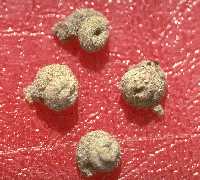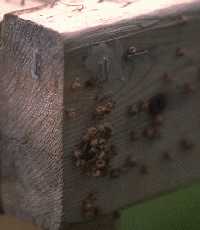by W.S. Cranshaw* (7/14)
Quick Facts…
- The snailcase bagworm is an unusual insect that lives within a small, coiled case of soil and silk.
- Although snailcase bagworms feed on various plants, the primary concern occurs when full-grown caterpillars migrate and attach themselves to the sides of buildings, fencing, mailboxes and similar sites.
- Although developing insects may be controlled, insecticides are ineffective against the migrating stages.

Figure 1: Snailcase bagworm. |

Figure 2: Snailcase bagworms attached to fence. |
The snailcase bagworm (Apterona helix, Family: Psychidae) is an unusual moth, native to Europe, that has recently been introduced into Colorado and is spreading through the state. By 1996, it had been found in all of the Western Slope counties and El Paso, Fremont and Boulder counties in eastern Colorado. Although the individual insects are wingless and cannot fly, snailcase bagworms attach to many surfaces and can easily be transported to new sites.
The developing insects feed on a wide variety of plants but rarely cause significant plant injury. Instead, problems occur as the full-grown larvae migrate to sites to pupate. During this time, large numbers may firmly attach themselves to sides of buildings, fences, mailboxes and other surfaces, creating a nuisance.
Life History
All stages of this insect take place within a coiled, snail-like case, approximately 1/8 inch in diameter. The caterpillars are greenish or reddish-gray with a black head. Adults are wingless and nearly legless moths. Only females are known to occur in Colorado.
Snailcase bagworms survive winter as young caterpillars protected within the case of the mother insect. They become active in midspring and feed on the leaves of a wide variety of native and cultivated plants, including sagebrush, saltbush, rabbitbrush, willow, mountain-mahogany, various fruit trees, squash, povertyweed and other wild crucifers, and alfalfa. The feeding injuries appear as small areas progressively gouged out of the leaf surface. Serious plant injury is rare.
As the larvae grow and develop, they produce a snail-like case of silk and soil particles. Later, they push their fecal matter out of an opening in the center of the case, allowing it to pile up on top of the insect. The larval insects are mobile and can carry the case upright. As they become full-grown, typically in late spring and early summer, snailcase bagworms migrate to high, shaded points. There they firmly attached themselves and transform to the pupal stage.
Transition to the adult moth takes place in the pupal covering after attachment. The moths are wingless, nearly legless, and do not feed. Only females are produced, but they can fertilize eggs asexually. About one to two dozen eggs are produced by the female. During midsummer, these eggs hatch. However, the young larvae remain in a dormant condition within the pupal covering throughout the winter. They emerge from the case the following spring and disperse, probably with the aid of wind, to new host plants.
Control
Controls for snailcase bagworm have not been developed. Control developing larvae on plants with insecticides such as Orthene and pyrethroids (e.g., Tempo, Talstar, Astro), which are known to be effective against other types of bagworms.
Full-grown, migrating larvae cannot be controlled with insecticides. To prevent the nuisance of migrating caterpillars attaching themselves to the sides of homes, temporary barriers (flanges, sticky tapes) may be feasible. Snailcase bagworms also may be dislodged with a vigorous jet of water (preferably soapy water) before they attach themselves to the surface in preparation for pupation. After attachment, these insects are not readily removed.
In most situations, controls for this insect are not warranted.
* Colorado State University Extension entomologist and professor, bioagricultural sciences and pest management. 12/96. Revised 7/14.
Colorado State University, U.S. Department of Agriculture, and Colorado counties cooperating. Extension programs are available to all without discrimination. No endorsement of products mentioned is intended nor is criticism implied of products not mentioned.
Go to top of this page.





